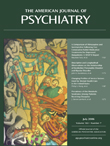What is easiest to measure gets measured and quantified and called real and scientific, especially in a complex field such as child and adolescent psychiatry. In an unfortunate contrast, what is far harder and takes far longer to measure gets measured very little and inadequately and is, in many respects, referred to as, and considered, unscientific or unimportant or unreal. This is true not just of the public but also of a great many of our colleagues. Although understandable, it is dangerous for our field.
In our era of innumerable articles on medicating symptoms, of managed care pressures, and of biological reductionism, it is valuable and even rather noble at least to try to measure some important things and clusters of things that are likely to be of vital interest to mental health and illness but are hard to measure, such as psychosocial treatments of child and adolescent psychiatric disorders. Of course successes in such areas are usually modest, but that should be taken not as a failure but as a realistic major challenge.
The book is large and reviews quite a few recently published so-called evidence-based studies of various psychosocial treatments for some child and adolescent psychiatric problems. Although it leaves out a great deal of important child and adolescent psychiatric understanding, research, prevention, and treatment, it contains summaries of many good and some complex ideas about treating youths and can serve as a reasonable review of several areas and theories in recent psychosocial treatment research. This book will be beneficial to many researchers and probably to NIMH grant-awarders and, far more obliquely, to some clinicians.
The majority of the book is devoted to chapters by many teams of authors, far more of them psychologists than psychiatrists. There are sections on treatments of anxiety disorders, affective and related disorders, attention deficit hyperactivity disorder, socially disruptive behaviors and conduct disorders, autistic disorders, and treatments not specific to a particular disorder. Several of the chapters embody energetic and many-sided treatments and interesting comparison groups dealing with several relevant systems at once. However, the large number of youth who do not fit into neat single diagnostic categories and/or who have additional qualities that the researchers consider disqualifying are given only brief discussion, which is common in such summaries of research.
The book contains two particularly useful introductory chapters and one epilogue that sensibly sketch or suggest a few attempts to put into context treatments for the diagnoses outlined above. One might be disappointed that the introduction and epilogue are not more detailed, with discussions of sympathetic but proper scientific skepticism of essential topics contained in the book—topics such as “evidence-based,” a currently popular and benign-sounding phrase that embodies many meanings and problems and remains somewhat propagandistic and smug; the great gaps in recent progress and knowledge, including the large areas of exclusion and ignorance around small segregated articles in the book; the problems of multiple overlapping imperfect diagnoses, combined with major relevant family and sociocultural factors; the problems of short follow-up times (3 months or even 1 year in child and adolescent work is considered long by many researchers but very short by many clinicians); the dilemma of integrating biopsychosocial understanding and prevention and treatment; the large and, in my view, deep and multi-sided problem of researchers versus clinicians.
Hibbs and Jensen helpfully point out some changes they have made to the book since the first edition. Likewise, they suggest the need for subtler and more useful comparison groups for understanding which components in therapies are efficacious, for combining child and adult understanding and therapies, for coping with individual variations in patients, for dealing with cultural factors, for trying comprehensive treatments and public health approaches, and for confronting researcher/therapist division. They are perhaps a bit brief in considering the possible usefulness of combining psychosocial therapies with medication therapies. They do, however, commendably urge scientists to design and engage in new research programs that will gradually take more complexity, more individual reality, and various commonly practiced treatments into account.

